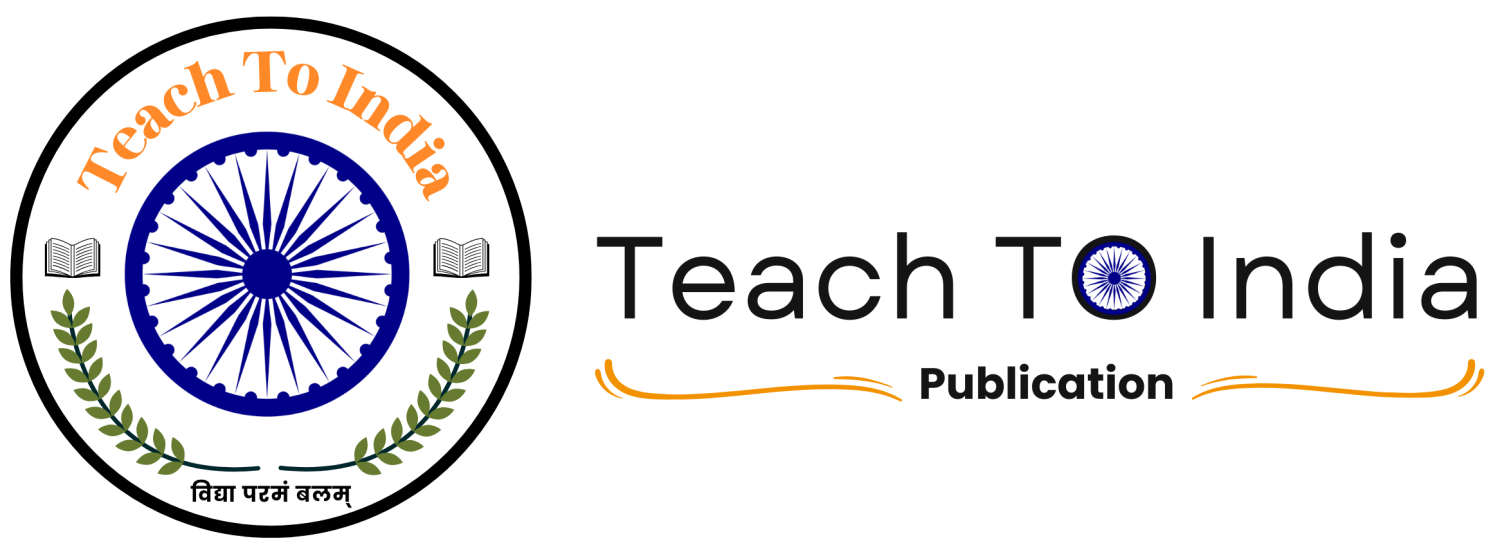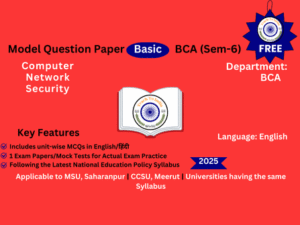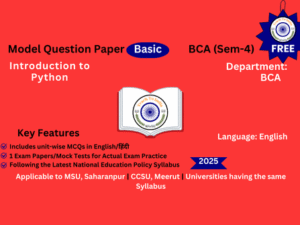सूक्ष्म जीवविज्ञान, एवं पादप रोगविज्ञान (सेमेस्टर -1)
- Description
- Curriculum
- Reviews

Teach To India प्रकाशन
सूक्ष्म जीवविज्ञान, एवं पादप रोगविज्ञान
-
यह मॉडल पेपर यह सुनिश्चित करता है कि सभी संभावित प्रश्न जो परीक्षा में आ सकते हैं, वे यूनिट में पूरी तरह से शामिल हैं, चाहे वे सीधे हों या अप्रत्यक्ष रूप से।
-
इसे अनुभवी प्रोफेसरों द्वारा बहुत सावधानी से तैयार किया गया है, जिन्हें परीक्षा मॉडल पेपर बनाने का व्यापक अनुभव है।
-
इस पेपर में विश्वविद्यालय द्वारा निर्धारित पाठ्यक्रम के आधार पर सभी मुख्य प्रश्न शामिल हैं।
-
400 से अधिक प्रश्न और उत्तरों के साथ, यह मॉडल पेपर विषय का पूरा पाठ्यक्रम कवर करता है।
-
प्रत्येक यूनिट में दीर्घ उत्तरीय ,लघु उत्तरीय और अति लघु उत्तरीय वाले प्रश्न शामिल हैं ताकि छात्रों को गहन समझ प्राप्त हो सके।
-
हमारे प्रश्न इस तरह तैयार किए गए हैं कि प्रत्येक यूनिट को कम से कम और अच्छी तरह चुने हुए प्रश्नों से कवर किया जा सके।
-
अनिवार्य आंतरिक परीक्षा के लिए हम 200 एक पंक्ति के प्रश्न-उत्तर प्रदान कर रहे हैं, जो प्रत्येक यूनिट को समान रूप से कवर करते हैं।
-
इस मॉडल पेपर में मॉक प्रश्नपत्र / पिछले साल के प्रश्नपत्र भी हल के साथ दिए गए हैं, जिससे छात्रों को परीक्षा के प्रश्नों की गहराई और विस्तार को समझने में मदद मिलती है।
Programme /Class: Certificate
Year: First
Semester: First
Subject: Botany
Course Title: Microbiology & Plant Pathology
Course outcomes:
After the completion of the course the students will be able to:
1. Develop understanding about the classification and diversity of different microbes including viruses, Algae, Fungi & Lichens & their economic importance.
2. Develop conceptual skill about identifying microbes, pathogens, biofertilizers & lichens.
3. Gain knowledge about developing commercial enterprise of microbial products.
4. Learn host –pathogen relationship and disease management.
5. Learn Presentation skills (oral & writing) in life sciences by usage of computer & multimedia.
6. Gain Knowledge about uses of microbes in various fields.
7. Understand the structure and reproduction of certain selected bacteria algae, fungi and lichens
8. Gain Knowledge about the economic values of this lower group of plant community.
Credits: 4
Core Compulsory
Max. Marks: 25+75
Min. Passing Marks: 8+25
Unit
Topics
I
A. Introduction to Indian ancient, Vedic and heritage Botany and contribution of Indian Botanists (in all branches), in context with the holistic development of modern science and technology, has to be taught, practiced and assessed via class interaction/ assignments / self-study mentioned under Continuous Internal Evaluation (CIE).
B. Microbial Techniques & instrumentation
Microscopy – Elementary knowledge of Light, phase contrast, electron, scanning and transmission electron microscopy, staining techniques for light microscopy, sample preparation for electron microscopy. Common equipment of microbiology lab and principle of their working – autoclave, oven, laminar air flow, centrifuge. Colorimetry and spectrophotometry, immobilization methods, fermentation and fermenters.
II
Microbial world
Cell structure of Eukaryotic and prokaryotic cells, Gram positive and Gram-negative bacteria, Structure of a bacteria and plasmids; Bacterial Chemotaxis and Quorum sensing, Bacterial Growth curve, factors affecting growth of microbes; measurement of growth; Batch culture, fed batch culture and continuous culture; Synchronous growth of microbes; Sporulation and reproduction and recombination in bacteria.
Viruses, general characteristics, viral culture, Structure of viruses,TMV and retro viruses, Bacteriophages, Structure of T4 &, λ-phage; Lytic and Lysogenic cycles, mycophages, viroid, Prions & mycoplasma & phytoplasma, Actinomycetes (Actinobacteria) and their economic uses.
III
Phycology
Range of thallus organization in Algae, Pigments, Flagella, Reserve food, Types of Reproduction, Classification and comparative life cycle of –
Nostoc, Chlorella, Volvox, Oedogonium, Chara; Ectocarpus, Sargassum, Polysiphonia.
Phycoviruses, Economic importance of algae – Role of algae in soil fertility- biofertilizer – Nitrogen fixation- Symbiosis; Commercialproducts of algae –biofuel, Agar, Diatomite.
IV
Mycology
Comparative study of general characteristics, nutrition, life cycle, Economic importance of Fungi, Classification upto class. Distinguishingcharacters of Myxomycota: General characters of True Fungi (Eumycota): Mastigomycotina Synchytrium: Zygomycotina: Rhizopus, Ascomycotina: Saccharomyces, Penicillium, Peziza. Basidiomycotina:
Ustilago, Puccinia, Agaricus; Deuteromycotina: Fusarium,Alternaria. Heterothallism, Physiological specialization, Heterokaryosis & Parasexuality,
V
Mushroom Cultivation, Lichenology & Mycorrhiza
Mushroom cultivation.
General account of lichens, reproduction and significance; Mycorrhiza: ectomycorrhiza and endomycorrhiza and their significance.
VI
Plant Pathology
Disease concept, Symptoms, Etiology & causal complex, Primary and secondary inoculum, Infection, Pathogenicity and pathogenesis, Koch‘s Postulates. Mechanism of infection (Brief idea about Pre-penetration, Penetration and Post- penetration), Disease cycle (monocyclic, polycyclic and polyetic). Defense mechanism with special reference to Phytoalexin, Resistance- Systemic acquired and Induced systemic fungicides- Bordeaux mixture, Lime Sulphur, Tobacco decoction, Neem cake & oil
VII
Diseases and Control
Symptoms, Causal organism, Disease cycle and Control measures of – Early & Late Blight of Potato, Black Stem Rust of Wheat, Alternaria spot‘ and ‗White rust of Crucifers, Red Rot of Sugarcane, Wilting of Arhar, Mosaic diseases on tobacco and cucumber, yellow vein mosaic of bhindi; Citrus Canker,
Little leaf of brinjal; Damping off of seedlings, Disease management: Quarantine, Chemical, Biological, Integrated pest disease management
VIII
Applied Microbiology
Elementary knowledge of Food fermentations and food produced by microbes, Production of amino acids, antibiotics, enzymes, vitamins, alcoholic beverages, organic acid & genetic recombinant vaccines. Mass production of bacterial biofertilizers, blue green algae, Azolla and mycorrhiza. Plant growth promoting rhizobacteria & biopesticides–– Trichoderma sp. and Pseudomonas, Single cell proteins (Spirulina), Organic farming inputs, Microbiology of water, Biopolymers, Bioindicators, Biosensors, Bioremediation, Production of biofuels, Biodegradation of pollutants and Biodeterioration of materials & Cultural Property. Microbial Biofactories (E.coli and Yeast) for production of recombinant proteins
-
1यूनिट-1: सूक्ष्म जीवविज्ञान, एवं पादप रोगविज्ञान
-
2यूनिट-2: सूक्ष्म जीवविज्ञान, एवं पादप रोगविज्ञान
-
3यूनिट-3: सूक्ष्म जीवविज्ञान, एवं पादप रोगविज्ञान
-
4यूनिट-4: सूक्ष्म जीवविज्ञान, एवं पादप रोगविज्ञान
-
5यूनिट-5: सूक्ष्म जीवविज्ञान, एवं पादप रोगविज्ञान
-
6यूनिट-6: सूक्ष्म जीवविज्ञान, एवं पादप रोगविज्ञान
-
7यूनिट-7: सूक्ष्म जीवविज्ञान, एवं पादप रोगविज्ञान
-
8यूनिट-8: सूक्ष्म जीवविज्ञान, एवं पादप रोगविज्ञान







